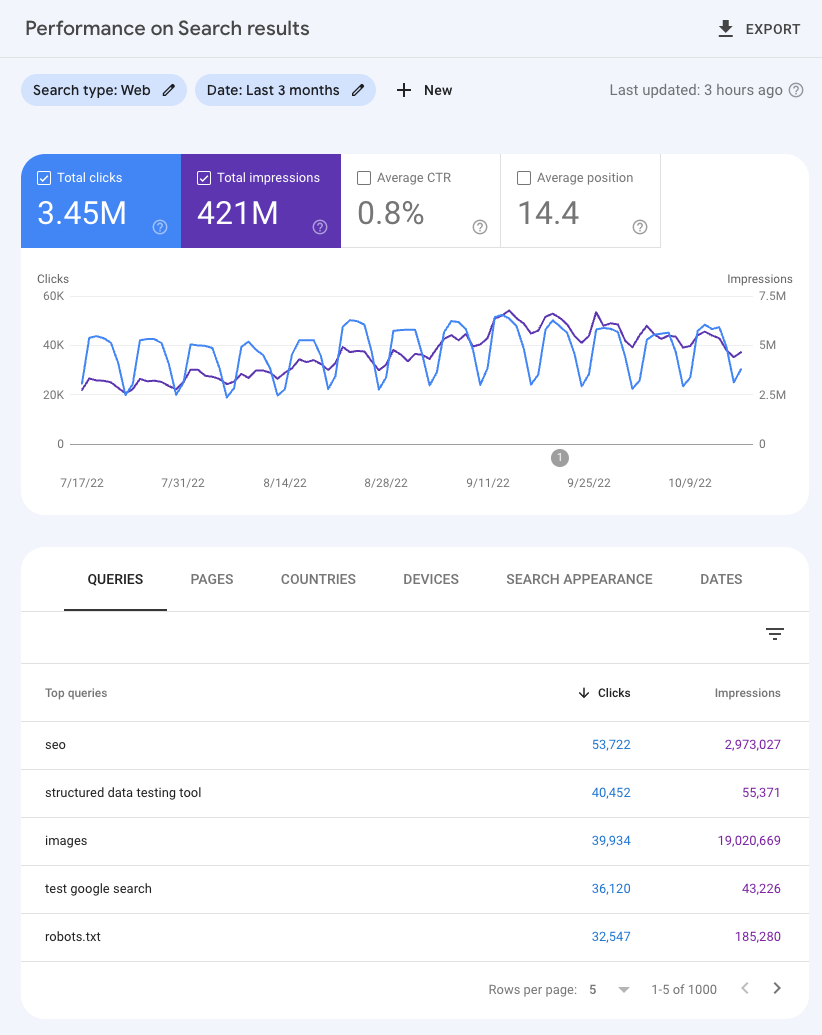วันพุธที่ 19 ตุลาคม 2022
ข้อมูลประสิทธิภาพของ Google Search เป็นข้อมูลที่มีการใช้กันอย่างแพร่หลายใน Search Console ทั้งผ่านรายงานประสิทธิภาพและ Search Analytics API โพสต์นี้อธิบายข้อมูลที่มีอยู่โดยละเอียดและวิธีที่ Google ประมวลผลข้อมูลเหล่านั้น ซึ่งรวมถึงการกรองความเป็นส่วนตัวและข้อจํากัดอื่นๆ ที่เกี่ยวข้องกับเวลาในการตอบสนองของการแสดงผล พื้นที่เก็บข้อมูล และทรัพยากรในการประมวลผล เคยสงสัยไหมว่าระบบเหล่านี้ทำงานอย่างไร เรามาเจาะลึกเรื่องนี้กัน
หากยังไม่เคยใช้ Search Console โปรดอ่านข้อมูลเบื้องต้นเกี่ยวกับรายงานประสิทธิภาพ
ข้อมูลเบื้องต้นเกี่ยวกับประสิทธิภาพในการค้นหา
รายงานประสิทธิภาพจะมีเมตริก 4 รายการที่แสดงให้เห็นว่าปริมาณการค้นหาเปลี่ยนแปลงไปอย่างไรเมื่อเวลาผ่านไป เรามีบทความซึ่งอธิบายวิธีคํานวณเมตริกแต่ละรายการ และสรุปเนื้อหาอยู่ที่ด้านล่าง
- การคลิก: จำนวนคลิกของผู้ใช้จากผลการค้นหาของ Google ไปยังพร็อพเพอร์ตี้ของคุณ
- การแสดงผล: จำนวนครั้งที่ผู้ใช้เห็นพร็อพเพอร์ตี้ของคุณในผลการค้นหาของ Google
- CTR (อัตราการคลิกผ่าน): จำนวนคลิกที่หารด้วยจำนวนการแสดงผล
- ตําแหน่ง: อันดับเฉลี่ยในผลการค้นหาสําหรับ URL ข้อความค้นหา หรือเว็บไซต์โดยทั่วไป
คุณวิเคราะห์เมตริกแต่ละรายการเพื่อดูมิติข้อมูลต่างๆ ได้ และสามารถตรวจสอบว่าการค้นหา หน้าเว็บ ประเทศ อุปกรณ์ หรือลักษณะที่ปรากฏในการค้นหาแต่ละรายการที่ทำให้เกิดการเข้าชมเว็บไซต์ของคุณทำงานมีประสิทธิภาพอย่างไร
คุณดูข้อมูลประสิทธิภาพของ Search ได้หลายวิธี เช่น อินเทอร์เฟซของผลิตภัณฑ์, Search Analytics API, เครื่องมือเชื่อมต่อ Looker Studio และสเปรดชีต (ต้องดาวน์โหลดด้วยตนเองจากอินเทอร์เฟซ)
หากคุณใช้อินเทอร์เฟซของผลิตภัณฑ์ มิติข้อมูลจะพร้อมให้ใช้งานผ่านตัวกรองหรือผ่านทางตารางมิติข้อมูลตามแผนภูมิดังที่แสดงในรูปภาพด้านล่าง

ข้อมูลนี้อาจใช้เพื่อค้นหาวิธีต่างๆ ที่จะทำให้คนเห็นเว็บไซต์มากขึ้นและ เข้าชมเว็บไซต์ของคุณจาก Google ในที่สุด โปรดดูตัวอย่างประเภทการวิเคราะห์ที่คุณดำเนินการได้ที่ตัวอย่างแผนภูมิการเพิ่มประสิทธิภาพ
การกรองและข้อจํากัดของข้อมูล
ทั้งข้อมูลในอินเทอร์เฟซของรายงานและข้อมูลที่ส่งออกจะมีการรวมและกรองด้วยวิธีที่แตกต่างกัน ด้านล่างนี้คือข้อจํากัดหลัก 2 ประการของข้อมูล ได้แก่ การกรองความเป็นส่วนตัวและขีดจํากัดรายวันสำหรับแถวของข้อมูล
การกรองเพื่อความเป็นส่วนตัว
ข้อความค้นหาบางรายการ (เรียกว่าข้อความค้นหาที่ไม่ระบุตัวบุคคล) จะไม่รวมอยู่ในข้อมูล Search Console เพื่อปกป้องความเป็นส่วนตัวของผู้ใช้ที่ทำการค้นหา
ข้อความค้นหาที่ไม่ระบุตัวบุคคลคือข้อความค้นหาที่ไม่ได้ดำเนินการโดยผู้ใช้หลายสิบคนในช่วง 2-3 เดือนที่ผ่านมา เพื่อปกป้องความเป็นส่วนตัว ระบบจะไม่แสดงข้อความค้นหาจริงในข้อมูลประสิทธิภาพของ Search เราจึงเรียกว่าข้อความค้นหาแบบไม่ระบุตัวตน แม้ว่าจริงๆ ข้อความค้นหาไม่ระบุตัวบุคคลจะไม่ปรากฏในตาราง แต่ระบบจะรวมข้อความเหล่านั้นในผลรวมของแผนภูมิ เว้นแต่ว่าคุณจะกรองตามข้อความค้นหาที่เจาะจง
ลองมาดูตัวอย่างเพื่อให้เห็นภาพได้ชัดขึ้น โปรดทราบว่านี่เป็นภาพจำลองที่ในกรณีที่มีการกรองความเป็นส่วนตัวเท่านั้น สำหรับเรื่องขีดจํากัดรายวันของแถวข้อมูล ซึ่งเราจะพูดถึงในส่วนถัดไป ก็อาจส่งผลกระทบต่อการแสดงข้อมูลได้เช่นกัน โปรดอ่านในส่วนถัดไปเพื่อดูข้อมูลเพิ่มเติม สมมติว่าตารางด้านล่างแสดงจำนวนการเข้าชมทั้งหมดไปยังเว็บไซต์ของคุณจากข้อความค้นหา โดยมีการจำแนกการเข้าชมตามคำค้นหาที่ระบุตัวบุคคล เว็บไซต์ทั่วไปจะมีข้อความค้นหาที่ระบุตัวบุคคลซึ่งได้รับการจำแนกมากกว่า 4 รายการอยู่แล้ว รายการที่จำแนก 4 รายการนี้จึงเป็นเพียงตัวอย่างเท่านั้น
| ข้อความค้นหา | การคลิก |
| วรรณกรรมคลาสสิก | 150 |
| บทกวี | 125 |
| นิยายวิทยาศาสตร์ | 100 |
| สารคดี | 75 |
| ยอดรวมของการคลิกจากข้อความค้นหาที่จำแนกรายการ | 450 |
| การคลิกทั้งหมด | 550 |
หากคุณรวมข้อความค้นหาที่จำแนกรายการทั้งหมดตามที่แสดงในแผนภูมิ คุณจะได้คลิก 450 ครั้ง แต่คลิกทั้งหมดไปยังเว็บไซต์จะเป็น 550 ครั้ง ตัวเลขที่สูงขึ้นเกิดจากการรวมคลิกที่จำแนกรายการทั้งหมด บวกกับ การคลิกจากข้อความค้นหาที่ไม่ระบุตัวบุคคล ซึ่งไม่ได้แสดงอยู่ในที่นี้
เวลาที่ใช้การรายงาน Search Console จริงๆ คุณอาจเห็นจำนวนที่ต่างกันนี้ได้จาก 2 สาเหตุ
- ตารางรายงานหรือ API (ใส่เข้ามาเพื่อให้เห็นภาพ) จะไม่มีแถวสำหรับข้อความที่ไม่ระบุตัวบุคคล ดังนั้นหากคุณรวมจํานวนคลิกสำหรับทุกแถว จำนวนที่ได้จะไม่เท่ากับผลรวมในแผนภูมิ เช่น ในกรณีนี้ยอดจะเป็น 450 เมื่อรวมแถว แต่จะเป็น 550 ในผลรวมของแผนภูมิ
- ระบบจะละเว้นข้อความค้นหาที่ไม่ระบุตัวบุคคลเมื่อมีการใช้ตัวกรอง ดังนั้นหากคุณเทียบจํานวนคลิกในผลรวมของแผนภูมิกับผลรวมของคลิกที่มี
some_stringและไม่มีsome_stringยอดที่ได้จะไม่เท่ากัน ในกรณีนี้ หากคุณใช้ตัวกรองเพื่อรวมเฉพาะคำค้นหาที่มีคำว่า "นิยาย" คุณจะเห็นจำนวนคลิก 175 ครั้ง และหากยกเว้นคำค้นหาที่มีคำว่า "นิยาย" คุณจะเห็นจำนวนคลิก 275 ครั้ง ยอดรวมการคลิกจะเป็น 450 ครั้ง แต่ยอดรวมในแผนภูมิจะเป็น 550 คลิก
ขีดจํากัดรายวันของแถวข้อมูล
ด้วยข้อจํากัดที่เกี่ยวกับเวลาในการตอบสนองของการแสดงผล พื้นที่เก็บข้อมูล ทรัพยากรในการประมวลผล และอื่นๆ Search Console จะจํากัดจํานวนข้อมูลที่สามารถแสดงหรือส่งออกได้ ข้อจำกัดเหล่านี้จะไม่ส่งผลต่อ พร็อพเพอร์ตี้ส่วนใหญ่ใน Search Console เว็บไซต์ขนาดใหญ่บางเว็บอาจได้รับผลกระทบจากข้อจำกัดนี้ แต่เราก็เชื่อว่าข้อมูลที่มีอยู่นั้นมากพอที่จะสร้างตัวอย่างข้อมูลที่ครบถ้วน
คุณส่งออกข้อมูลผ่านอินเทอร์เฟซผู้ใช้ของ Search Console ได้มากสุดคือ 1,000 แถว
ปัจจุบัน ขีดจํากัดสูงสุดของข้อมูลที่ส่งออกผ่าน Search Analytics API
(และผ่านเครื่องมือเชื่อมต่อ Looker Studio) คือ 50,000 แถวต่อวันต่อเว็บไซต์ต่อประเภทการค้นหา ซึ่งอาจไม่ถึงในบางกรณี ค่าเริ่มต้นที่แสดงผลโดย API จะเป็น 1,000 แถว แต่คุณสามารถใช้ rowLimit เพื่อเพิ่มเป็น 25,000 แถว และใช้ startRow เพื่อดึงแถว 25,001 ถึง 50,000 แถวโดยใช้การแบ่งหน้า อ่านคู่มือนี้เพื่อดูวิธีรับข้อมูลที่มีอยู่
สําหรับคําขอที่ไม่เกี่ยวข้องกับข้อความค้นหาหรือมิติข้อมูล URL เช่น ประเทศ อุปกรณ์ และลักษณะที่ปรากฏในการค้นหา Search Console จะแสดงและส่งออกข้อมูลทั้งหมด
แหล่งข้อมูลและความคิดเห็น
หากต้องการดูข้อมูลเพิ่มเติมเกี่ยวกับเรื่องนี้ โปรดอ่านเอกสารประกอบเกี่ยวกับประสิทธิภาพ คุณจะพบคําอธิบายเชิงลึกเกี่ยวกับข้อมูลที่มีให้ วิธีใช้รายงานประสิทธิภาพ และรายละเอียดเพิ่มเติมเกี่ยวกับยอดที่ไม่เท่ากันที่คุณอาจพบในแผนภูมิ
หากมีข้อสงสัยหรือข้อกังวลใดๆ โปรดติดต่อเราผ่าน ชุมชน Google Search Central หรือใน Twitter
